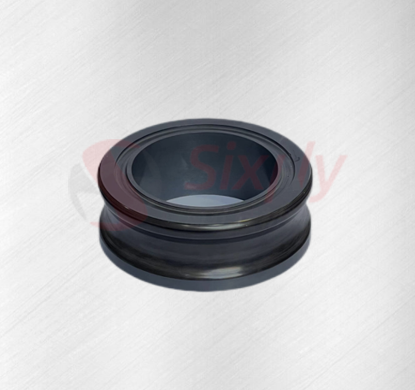
Silicon nitride insulation ring
Silicon nitride insulation ring will not react with hydrogen, hydrogen chloride, silicon chloride and other gases, good stability, can play a
heat insulation, anti-corrosion, high temperature resistance effect, can effectively prevent the peeling carbon felt and other conductive
materials will be connected to the electrode and chassis, resulting in short circuit phenomenon, but also can be isolated from the high
temperature in the reduction furnace, so as to avoid the reduction furnace hydrogen leakage or explosion and other safety accidents.
Silicon nitride ceramic ring has good insulation, high toughness, high temperature resistance and good shock resistance, which can meet
the environmental requirements of polysilicon reduction furnace, improve work efficiency, and the service life is more than 10 times that
of alumina insulated ring.
Advantages of silicon nitride insulation ring:
Has a strong corrosion resistance: can be used in strong oxidants, dissolved hydrochloric acid in addition to hydrochloric acid, it does not
react with other strong oxidants;
High temperature resistance strength is very high: silicon nitride ceramics at 1200℃ temperature, the compressive strength will almost
not change, can be applied in high temperature environment, after heat is not easy to melt into melt, if until 1900℃ high temperature will
dissolve;
No magnetic conductivity, insulation, low heat transfer: can be used as insulation layer insulation material;
Low density, light weight, compressive strength and strength far beyond the general structural ceramics: can be used as metal
composite materials;
Low linear expansion coefficient: equal to 30% of alumina ceramics, not 40% of zirconia ceramics, can bear a large temperature change
in the air temperature to more than 1000 ° C, large cooling and then large heating, will not break.
Silicon nitride insulation ring performance indicators :
Performance | Ⅰ | Ⅱ | Ⅲ | ||
Density/(g/cm³) | 3.15≤ρ≤3.25 | ||||
Elastic modulus/GPa | 270≤E≤330 | ||||
Poisson's ratio | 0.23≤μ≤0.29 | ||||
Coefficient of thermal expansion (room temperature to 500℃)/X10-6/℃ | 2.0≤α≤3.7 | ||||
Bending strength/MPa | Four-point test | ≥750 | ≥650 | ≥530 | |
Three-point test | ≥820 | ≥720 | ≥550 | ||
Vickers hardness(HV) | ≥1420 | ≥1330 | ≥1270 | ||
Fracture toughness | ≥6 | ≥5 | ≥5 | ||
Crushing load ratio | 40% | 35% | 30% | ||
microcosmic structure | Air hole/μm | ≤10 | ≤10 | ≤25 | |
Inclusion | 25<S≤50 | ≤4 | ≤8 | ≤16 | |
50<S≤100 | ≤1 | ≤2 | ≤4 | ||
100<S≤200 | 0 | ≤1 | ≤25 | ||
S>200 | 0 | 0 | ≤1 | ||
Ceramic product processing accuracy :
Item | Precision value | ||||
Dimensional exact values | Up to 0.001mm | ||||
Degree of finish | Up to mirror | ||||
The number of concentricities | Up to 0.003mm | ||||
The number of parallelism | Up to 0.002mm | ||||
Bore tolerance | The minimum can be machined 0.005mm | ||||
Straight groove | The narrowest machined groove is 0.1*100mm | ||||
Thickness dimension | Minimum machining to 0.08mm | ||||
Screw thread | Min machining inner thread M2, outer thread no limited | ||||
Cylindricity dimension | Up to 0.004mm | ||||
Linear tolerance | Up to 0.001mm | ||||
Min aperture | The minimum processing capacity is 0.07mm |
Application: photovoltaic reduction furnace field.

 19194976688
19194976688




